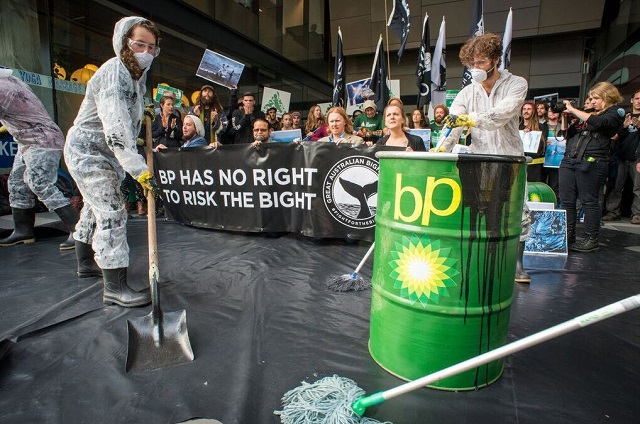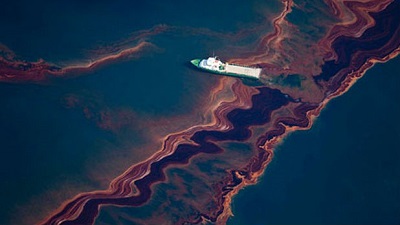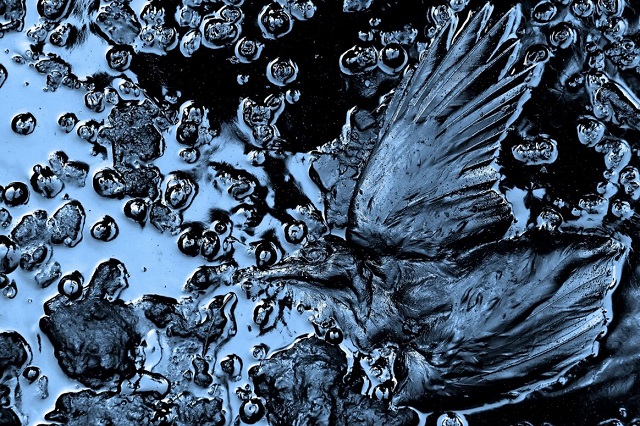Update: Sea Shepherd in Australian BP Protest
Protestors helped clean up a mock oil spill outside BP’s headquarters in Melbourne on Thursday to highlight the British company’s plans to drill for oil in the Great Australian Bight.
On the other side of the world later on Thursday there will also be a protest at BP’s annual general meeting in London. BP’s plans for the Bight have also been targeted by two recent protests in London calling for the British Museum to end its BP sponsorship deal.
 Credit: Glenn Walker
Credit: Glenn Walker
“We are here to tell BP it has no right to risk the pristine waters of the Great Australian Bight, and that the opposition to its plans is growing in Australia and around the world,” said Wilderness Society South Australia Director Peter Owen.
“We want to remind people that BP was the company responsible for the world’s biggest oil spill accident, the Deepwater Horizon tragedy in 2010, when 800 million liters of oil spewed into the Gulf of Mexico for 87 days. BP totally stuffed up in the deep waters of the Gulf of Mexico. Now BP wants to drill in the deeper, more treacherous and more remote waters of the Great Australian Bight. You have got to be kidding.
“BP has already shown it has not learnt anything from its Gulf of Mexico disaster. Australia’s offshore oil and gas authority, NOPSEMA, rejected BP’s first application to drill in the Bight and had said BP needs a comprehensive risk assessment and oil pollution emergency plan. The Australian Senate is so concerned about BP’s plans it has launched an inquiry into them.
“BP has not even released detailed oil spill modelling. It claims an oil spill will last only 35 days even though the Macondo well spewed billions of liters of oil into the Gulf of Mexico for 87 days,” says Owen.
“An oil spill in the Bight would be devastating for South Australia’s $442 million fishing industry and its tourism industries in coastal regions, worth more than $1 billion. The two industries employ more than 10,000 full-time positions.”
Sea Shepherd Australia Managing Director Jeff Hansen said: “The Great Australian Bight is a global marine treasure. The Bight’s pristine waters are a haven for whales, boasting the world’s most important southern right whale nursery as well as many humpback, sperm, blue and beak whales. These are the same whales we fight so hard to protect from slaughter in the Southern Ocean.
“The Bight is Australia’s most important sea lion nursery. It also supports dolphins, seals, orcas, great white sharks, some of Australia’s most important fisheries, and magnificent birds such as the albatross and the white-bellied sea eagle.
“The Bight is littered with state and federal marine parks. One of BP’s leases even takes in a Commonwealth marine reserve,” says Hansen. “The Great Australian Bight is backed by the longest line of sea cliffs in the world, stretching hundreds of kilometers and reaching 60 meters high, the height of a 20-storey building, making it even more difficult for any clean-up operations if there was a spill.

“And the impact would be long lasting. Six years after the Gulf of Mexico disaster, its impacts are still being felt today, with dead marine life still washing up on beaches, dolphins unable to reproduce and people getting sick while local tourism, fishing and other businesses have not recovered.”
The Great Australian Bight Alliance includes the Wilderness Society, Sea Shepherd Australia, Sea Shepherd UK, Surfrider Foundation Australia, the Australian Marine Conservation Society, Mirning and Kokatha elders, Oil Free Seas Kangaroo Island and Clean Bight Alliance (West Coast SA).
Drilling Concerns
.png) Australia’s offshore oil and gas authority, NOPSEMA, has already rejected BP’s first application to drill four exploration wells in the Bight because of inadequacies in its plans but did not reveal details to the public. NOPSEMA had earlier said BP needs a comprehensive risk assessment and a comprehensive oil pollution emergency plan.
Australia’s offshore oil and gas authority, NOPSEMA, has already rejected BP’s first application to drill four exploration wells in the Bight because of inadequacies in its plans but did not reveal details to the public. NOPSEMA had earlier said BP needs a comprehensive risk assessment and a comprehensive oil pollution emergency plan.
Independent modelling, released last year, showed that an oil spill in the Bight from a deep-sea well blowout would be devastating for fisheries, marine life and tourism. The model shows that an oil spill in the Great Australian Bight could result in the closure of fisheries in the Bight, Bass Strait and even the Tasman Sea. Even a low-flow oil spill could impact all of southern Australia’s coast, from Western Australia to Victoria through Bass Strait and around Tasmania.
Preparing to Drill
On March 15, 2016, BP resubmitted its Environment Plan for exploration drilling in the Great Australian Bight to NOPSEMA. BP provides some details of the project and its environmental plans here.
Also last month, BP officially opened one of its first key infrastructure projects in South Australia, in support of the BP-Statoil Great Australian Bight exploration program.
BP’s Marine Supply Base, located at Port Adelaide and the first facility of its kind in South Australia, will play an integral role in the safe and efficient day-to-day operations of BP’s planned exploration program.
The Marine Supply Base will be used to provide specialist materials to the ultra-deepwater harsh environment semisubmersible Ocean GreatWhite, store large amounts of equipment, host a drilling fluids plant and provide a dedicated wharf area for supply vessels.
“The oil and gas industry as a whole has the potential to bring significant economic and social benefits to South Australia,” said Claire Fitzpatrick, BP’s Managing Director, Exploration and Production, Australia.
Deepwater Horizon
On the evening of April 20, 2010, a blowout, explosions, and fire occurred on board the Deepwater Horizon as it was in the process of temporarily abandoning the exploratory well Macondo that it had drilled in the Gulf of Mexico, some 50 miles from the Louisiana coast and in 5,000 feet of water.
 Eleven men died in the incident and at least seventeen others were seriously injured. At the time of the blowout, a 5,000 foot-long riser connected the Deepwater Horizon to the well. Hydrocarbons from the well travelled up the riser to the rig, fueling the fire. Deepwater Horizon capsized and sank on April 22.
Eleven men died in the incident and at least seventeen others were seriously injured. At the time of the blowout, a 5,000 foot-long riser connected the Deepwater Horizon to the well. Hydrocarbons from the well travelled up the riser to the rig, fueling the fire. Deepwater Horizon capsized and sank on April 22.
As it descended, the marine riser collapsed and fractured. Oil and gas then poured into the Gulf via breaks in the riser near the seafloor. These events triggered a massive response—unprecedented in size and complexity—to combat the oil spill. On April 29, 2010, the incident was declared a “Spill of National Significance” under the National Contingency Plan. This was the first oil spill to receive such a designation.
Efforts to regain control of the well and stop the source of the discharge finally succeeded on July 15, 2010, nearly three months after initial blowout. By that time, approximately 3.19 million barrels of oil had entered the Gulf.
BP will pay a Clean Water Act penalty of $5.5 billion (plus interest), $8.1 billion in natural resource damages, up to an additional $700 million to address injuries to natural resources that are presently unknown and $600 million for other claims, including claims under the False Claims Act, royalties and reimbursement of natural resource damage assessment costs and other expenses due to this incident. Taken with the related agreement which requires BP to pay approximately $5.9 billion to the states and local government entities, BP will be paying a total of over $20 billion, the largest settlement with a single entity in the history of federal law enforcement.

